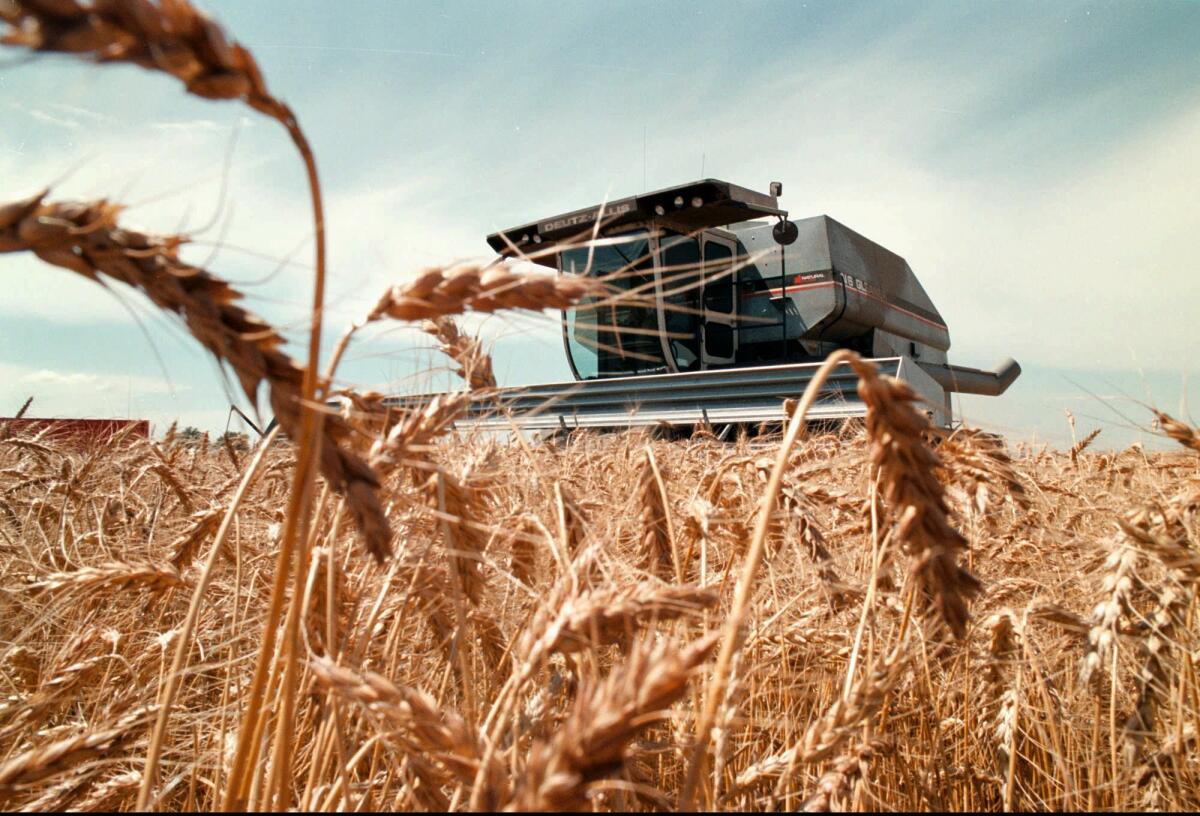Cities’ food supplies are eating into groundwater reserves, study finds

Dwindling groundwater supplies from three heavily depleted aquifers, including one in California, are used to grow 18.5% of the nation’s cereal grains, a new study says.
Groundwater in America’s major aquifers is being used up way faster than it’s being replenished. But where does all that water go?
A lot of it is used in producing food for the nation’s city dwellers, a new study calculates.
Rather than try to figure out how much water farmers use in comparison with how much cities demand, the study’s authors looked at the foods that groundwater is used to grow — and who gets to eat them.
“Cities and farms are linked,” said Megan Konar, a hydrologist in the Civil and Environmental Engineering Department at the University of Illinois at Urbana-Champaign and one of the authors of the study. “Rural areas produce the food that is consumed in urban areas. Sometimes we forget that.”
Konar and her colleagues wanted to know who eats the food produced with water from the most depleted aquifers in the United States. They looked at three of the most overdrawn groundwater systems in the country: the High Plains aquifer in the Midwest, the Mississippi Embayment aquifer in the Southeast and the Central Valley aquifer in California.
For each system, the researchers examined how much groundwater was withdrawn for agricultural irrigation, how many crops were produced using the groundwater, and how much water each type of crop consumed until it was ready for harvest. They also tracked where each crop was shipped.
They used publicly available data for their research: U.S. Geological Survey estimates of groundwater withdrawals for irrigation, U.S. Department of Agriculture estimates of crop production and the nonprofit Water Footprint Network estimates of how much water each type of crop needs to grow to maturity. The researchers used the U.S. Census Bureau’s Commodity Flow Survey and harbor-level export data to track where crops were distributed.
In doing so, they were able to calculate the amount of groundwater from each aquifer that was embodied in the crops and where those crops were eaten. They used figures from 2005 and 2007, as those were the most recent years that detailed data were available.
About 70% of the freshwater pumped up from America’s aquifers in 2005 was used for agriculture and livestock production, the Geological Survey reported.
Overall, in the three aquifers the study authors examined, an average of 27% of the water withdrawn for agricultural purposes wasn’t actually used to grow crops or raise livestock — it either evaporated before a plant could absorb it or it percolated back through the soil to the groundwater, Konar said.
Of the groundwater from the three aquifers that did go to economic use, nearly a third of it went to producing meat and animal feed, the researchers reported this week in the Proceedings of the National Academy of Sciences. Of the remaining water, approximately 32% went to growing grains and manufacturing grain products, about 28% was used to grow oils and make other processed foods and the final 8% was pumped to grow fruits, vegetables and nuts.
More of this food goes to urban Californians than to anyone else.
The researchers found that 12.7% of the water pulled from the three aquifers is delivered in the form of food to people in the cities of Los Angeles, Long Beach, Riverside, San Francisco, Oakland and San Jose. About 8% of the U.S. population lives in the metropolitan areas of those six cities, according to the 2010 Census.
Nearly a third of the water in the Central Valley aquifer grows food for people in the Los Angeles area, the San Francisco Bay Area and Sacramento. Nearly a quarter of the Mississippi Embayment groundwater produces food for New Orleans. Food grown from the High Plains aquifer is dispersed to metropolitan areas around the country. And 6% of the water from the three aquifers goes to growing food that is shipped overseas, primarily to Asia.
“Water use in rural areas largely serves urban areas by providing food,” the study authors wrote.
Overall, these three aquifers produce 18.5% of the nation’s cereal grains, making them critical to the U.S. food supply. They also are important internationally, producing 10% of Taiwan’s cereal supply.
“When I say cereal, I don’t mean Frosted Flakes. I mean all the bulk commodities, like wheat, rice, corn, barley,” Konar said. “A lot of people who look at food security focus on cereals because they’re responsible for the vast majority of global calorie consumption. So impacts to cereals have ripple effects to food security.”
Since 2007 — the latest year available for the study — it’s likely that even more groundwater has been taken out of the Central Valley aquifer to grow crops, said Heather Cooley, the water program director for the Pacific Institute, a nonprofit think tank in Oakland not affiliated with the study.
“We know that when there’s a drought, we are pumping a lot more groundwater,” Cooley said. “We’re probably even more dependent on groundwater than we were back then.”
But the Central Valley aquifer, along with the High Plains aquifer and the Mississippi Embayment aquifer, are being used much faster than nature is refilling them.
This unsustainable use puts the nation’s food supply at risk, Konar said. Experts say climate change will cause more variable rainfall and more droughts, which would make groundwater reserves increasingly valuable in the future, she said.
“Mining these groundwater resources now is essentially trading off future food security with current agricultural production,” she said. “A lot of consumers in the U.S. don’t realize that their food supply is reliant on these finite resources.”
For more science news, follow me on Twitter @sasha_hl and “like” Los Angeles Times Science & Health on Facebook.






